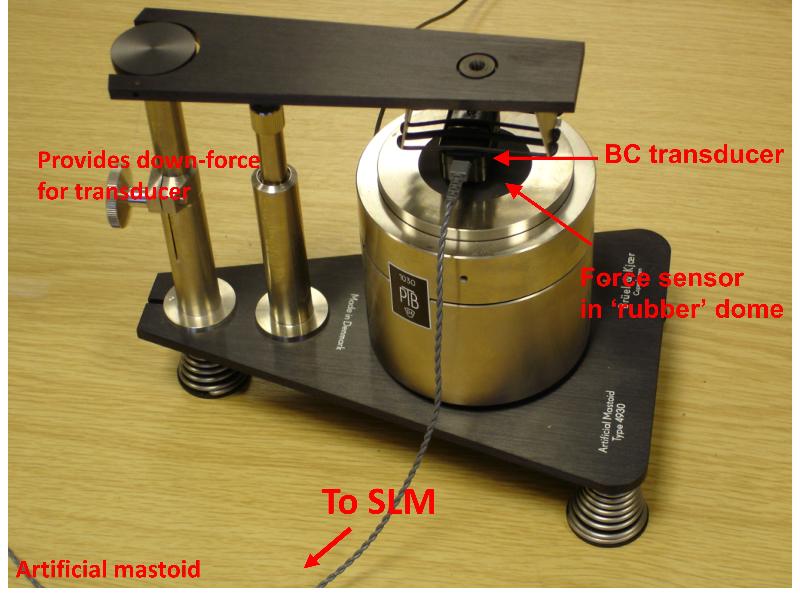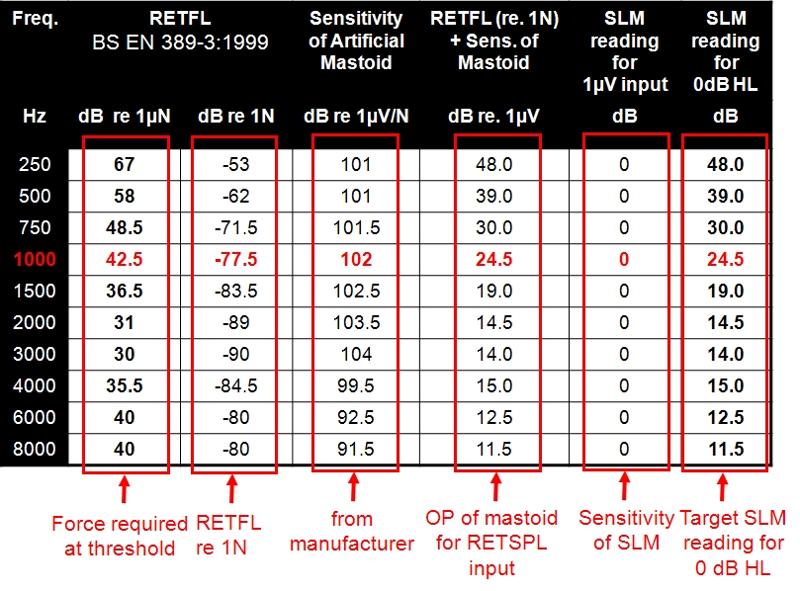Bone Conduction Calibration
The same basic principles apply to BC calibration as they do to AC calibration apart from a few aspects:
- Force level rather than sound level is what is measured
- The artificial mastoid is more temperature sensitive than the artificial ears
- The audiometer dial level used has to be lower (e.g. 40 dB HL)
- The calibration procedure needs to take into account the sensitivity of the artificial mastoid.
Procedure
As with AC calibration the basic principle is that the audiometer playes a signal through the transducer and this is measured on a coupler, in this case an artificial mastoid. The artificial mastoid has a sensor under a 'rubber' dome that picks up the vibratory force applied by the bone-vibrator. The signal from this sensor is then passed to the sound level meter and a reading can be made. The figure below shows an example of an artificial mastoid.
Figure 10 - Example of an artificial mastoid

Figure 10 - Example of an artificial mastoid with a bone-conduction transducer paced on the vibration sensing 'rubber' dome.
The output of the mastoid (displayed on the SLM) is then compared with what we should expect. However, it is this expected value that is slightly more complex then for AC calibration. In AC calibration we can use the sound level calibrator to check that the mearurement system is giving the correct reading. Without specialist equipment we can't do this for bone conduction we have to rely on (a) the manufacturers (or other) calibration certificate for the artificial mastoid, and (b) that the sensitivity of the SLM is correct for the particular voltage into the SLM. This is because the artificial mastoid gives a particular voltage for a particular force level applied to the sensor - we need to know this sensitivity so that we can equate the voltage out of the mastoid with a force going in. However, in order to measure the voltage coming out, we also need to know what voltage going into the SLM gives a particular reading. So for example:
- The sensitivity of the mastoid at 1kHz might be: 102dB re 1μV/N, this means that if 1N force is applied to the mastoid, then the output of the mastoid would be 102 dB greater than 1μV.
- The sensitivity of the SLM might be: 0dB re 1μV, this means that if 1μV voltage goes into the SLM, then the dial reading would be 0dB
These two aspects need to be taken into account in the calculation of what value we would expect on the SLM. The following describes the stages in this calculation.
- The standard (BS EN ISO 389-3:1999) specifies the Reference Equivalent Threshold Force Level (RETFL) (42.5 dB re 1μN) i.e. for otologically normal young adults the force corresponding to 0 dB HL should be 42.5 dB greater than 1μN. At this point it may helpful to express this in dB re. 1N, depending on how the sensitivity of the mastoid is presented - for this example 42.5 dB re 1μN = -77.5 dB re 1N.
- We next need to obtain the sensitivity of the mastoid from the calibration sheet (typically expressed in 1μV/N) - this might be, for example 102dB re 1μV/N.
- Next we need to combine these two to get the voltage from the mastoid that we would expect if a force corresponding to the RETFL value was applied to the mastoid. This is simply the RETFL (in appropriate units) plus the sensitivity of the mastoid. In this case: -77.5 dB re 1N + 102 dB re 1μV/N = 24.5 dB re. 1μV.
- In other words, if the audiometer dial was set to 0 dB HL we would expect a voltage out of the mastoid of 24.5 dB re. 1μV
- So, we know what voltage we expect for 0 dB HL, we could measure this in an oscilloscope, but more usually the mastoid is connected to an SLM in which case we need to know what voltage going into the the SLM corresponds to zero dB on the display (i.e. the sensitivity of the SLM - in this example we will assume it is 1μV for 0dB.
- The output of the mastoid for the applied RETFL value in this example is 24.5 dB re. 1μV and the sensitivity of the SLM is 1μV for 0dB so if we set the audiometer dial to 0dB HL the expected reading on the SLM would be 24.5 dB (please note that this is not dB SPL, strictly speaking it is in units of dB re. 1μV).
So, to summarise:
RETFL (dB re 1N) + mastoid sensitivity (dB re 1μV/N) +SLM sensitivity (dB re. 1μV) = expected value for 0dB HL
So for our example:
-77.5 dB re 1N + 102 dB re 1μV/N + 0dB re. 1μV = 24.5 dB re. 1μV
But remember we set the audiometer dial to 40 dB HL to get a good signal to noise ratio, so we need to add 40 dB to this value i.e. 64.5 dB re. 1μV. That is, for 1kHz, with this mastoid, for a 40dB dial setting we would expect a reading of 64.5 dB on the SLM. We can then compare this to the measured SLM reading and make sure that they are within 3dB of each other.
The table below gives an example set of values for the range of frequencies:
Table 4 - example calculation of the required SLM reading corresponding to 0 dB HL for BC

Table 4 - Example calculations of the expected SLM reading that should correspond to 0 dB HL for bone-conduction. The first two columns are the equivalent of the RETSPL values for BC. The difference is that for AC we can calibrate the measurement system so that we know exactly what we are getting in dB SPL. With BC, the sensitivity of the artificial mastoid varies from device to device and we don't have the equivalent of a sound level calibrator to check this so we need to rely on the manufacturers sensitivity values (column 3),or those of provided by accredited calibration institution who has the specialist equipment to do calibrate the mastoid. Column 4 then combines columns 2 and 3 to give the voltage (in dB) out of the mastoid that should correspond to 0 dB HL. If 1μV into the SLM gives a reading of 0dB then the 4th and 6th column should read the same.
Cautions
Because of the nature of the artificial mastoid it is very temperature sensitive and so needs to have had plenty of time to adjust to the temperature of the room before being used.
Care must be taken to centre the bone conductor on the center of the 'rubber' dome
The audiometer must be set at a level for a good enough signal to noise ratio, but one that won't produce significant distortion.
References
BS EN ISO 389-3:1999 Acoustics. Reference zero for the calibration of audiometric equipment - Part 3: Reference equivalent threshold force levels for pure tones and bone vibrators